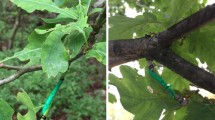Abstract
The hoopoe (Upupa epops L.) is an insectivorousbird often preying on larvae and pupae of the pineprocessionary caterpillar (Thaumetopoeapityocampa Denis & Schiffermüller), the mostimportant defoliator of pines in Southern Europe andNorthern Africa. The first half of the breeding seasonof this migratory bird coincides with the pupal stageof the insect. Bird predation of pupae was quantifiedin two years in a Pinus nigra stand of northernItaly by periodic counting of the empty cocoons lefton the soil surface after extraction. The predationrate, estimated on 20 pupation sites representing thewhole stand, was 74.1% in 1993 and 68.3% in 1994.Predation was higher in the upper part of the soil andthen progressively decreased with increasing depth.The hoopoe may also prey on cocoons containing pupaeinfected by pathogenic fungi or parasitoids. Anexclosure experiment showed that the bird mayinterfere with these other mortality factors. Threepupal parasitoids, the ichneumonids Erigorgusfemorator Aubert and Coelichneumon rudis (Boyerde Fonscolombe) and the pteromalid Conomoriumpityocampae Graham, were significantly less frequentin the exposed sites. The fungus Beauveriabassiana (Balsamo) Vuillemin and the most abundantpupal parasitoid, Villa brunnea Becker (Diptera:Bombyliidae), caused the highest pupal mortality atboth protected and exposed sites. The bird seems to bean incompletely additive mortality factor acting onthe pest and it can also alter the relativemortalities imposed by the other natural enemies.
Similar content being viewed by others
References
Androic, M., 1956. Contribution à l'étude de Cnethocampa pityocampa Schiff. Revue Path. vég.Ent.agric.Fr. 35: 251–262.
Battisti, A., 1986. Observations on the predation of Thaumetopoea pityocampa by the hoopoe Upupa epops. Avocetta 10: 119–121 (in Italian, English summary).
Bernardi, M., C. Ghiraldo and A. Battisti, 1995. The hoopoe Upupa epops as a regulating factor of the populations of Thaumetopoea pityocampa. Avocetta 19: 129 (in Italian, English summary).
Berryman, A.A., 1987. The theory and classification of outbreaks. In: P. Barbosa and J.C. Schultz (eds), Insect Outbreaks. Academic Press, San Diego. pp. 3–29.
Biliotti, E., 1958. Les parasites et prédateurs de Thaumetopoea pityocampa Schiff. (Lepidoptera). Entomophaga 3: 23–24.
Buckner, C.H., 1967. Avian and mammalian predators of forest insects. Entomophaga 12: 491–501.
Ceballos, P., 1969. Vertebrates preying on Thaumetopoea pityocampa Schiff. and possibilities of their use. Boln Serv.Plagas for. 12: 35–38 (in Spanish, French and English Summary).
Cramp, S., 1985. Handbook of the Birds of Europe, the Middle East and North Africa.Vol. IV: Terns to Woodpeckers. Oxford University Press, Oxford.
Dahlsten, D.L., W.A. Copper, D.L. Rowney and P.K. Kleintjes, 1990. Quantifying bird predation of arthropods in forests. Stud.Avian Biol. 13: 44–52.
Démolin, G., 1969. Bioecologia de la procesionaria del pino Thaumetopoea pityocampa Schiff. Incidencia de los factores climaticos. Boln Serv.Plagas for. 12: 9–24 (in Spanish, French and English Summary).
Démolin, G., 1971. Incidence de quelques facteurs agissant sur le comportement social des chenilles de Thaumetopoea pityocampa Schiff. (Lepidoptera) pendant la période des processions de nymphose. Répercussion sur l'efficacité des parasites. Annls Zool.-Écol.anim., vol. hors-série 'La Lutte biologique en Forêt'. pp. 33–56.
Dial, R. and J. Roughgarden, 1995. Experimental removal of insectivores from rain forest canopy: direct and indirect effects. Ecology 76: 1821–1834.
Du Merle, P., 1969a. The hypogean parasites of Thaumetopoea pityocampa Schiff. Boln Serv.Plagas for. 12: 29–34 (in Spanish, French and English Summary).
Du Merle, P., 1969b. Existence de deux diapauses facultatives au cours du cycle biologique de Villa brunnea Beck. (Dipt., Bombyliidae). C.R.hebd.Séanc.Acad.Sci., Paris D 268: 2433–2435.
Du Merle, P., 1979. Biologie de la larve planidium de Villa brunnea Beck., Diptère Bombyliide parasite de la Processionnaire du Pin. I) Recherche et découverte de l'hôte. Annls Zool.-Écol.anim. 11: 289–304.
Graham, V. de, 1992. The European species of the genus Conomorium Masi, 1924 (Hym. Pteromalidae) including one new to science. Entomologist's mon.Mag. 128: 197–202.
Halperin, J., 1990a. Life history of Thaumetopoea spp. (Lep., Thaumetopoeidae) in Israel. J.Appl.Entomol. 110: 1–6.
Halperin, J., 1990b. Natural enemies of Thaumetopoea spp. (Lepidoptera: Thaumetopoeidae) in Israel. J.Appl.Entomol. 109: 425–435.
Hirschfeld, H. and K. Hirschfeld, 1973. Zur Brut-und Ernährungsbiologie des Wiedehopfes, Upupa epops L., unter Berücksichtigung seiner Verhaltensweisen. Beitr.Vogelk. 19: 81–152.
Holmes, R.T., 1990. Ecological and evolutionary impacts of bird predation on forest insects: an overview. Stud.Avian Biol. 13: 6–13.
Holmes, R.T., J.C. Schultz and P. Nothnagle, 1979. Bird predation on forest insects: an exclosure experiment. Science 206: 462–463.
Lamy, M., 1990. Contact dermatitis (erucism) produced by processionary caterpillars (genus Thaumetopoea). J.Appl.Entomol. 110: 425–437.
Mills, N.J., 1994. Parasitoid guilds: defining the structure of the parasitoid communities of endopterygote insect hosts. Environ.Entomol. 23: 1066–1083.
Morse, D.H., 1971. The insectivorous birds as an adaptive strategy. Annu.Rev.Ecol.Syst. 2: 177–200.
Otvos, I.S., 1979. The effects of insectivorous bird activities in forest ecosystems: an evaluation. In: J.G. Dickson, R.N. Connor, R.R. Fleet and J.A. Jackson (eds), The Role of Insectivorous Birds in Forest Ecosystems. Academic Press, New York. pp. 341–374.
Rice, W.R., 1989. Analyzing tables of statistical tests. Evolution 43: 223–225.
Roberti, D., 1954. Observations on the biological control of the Pine processionary moth. Annali Fac.Agr.Univ.Milano 51: 86–96 (in Italian, English Summary).
Sokal, R.R. and F.J. Rohlf, 1995. Biometry. W.H. Freeman and Company, New York.
Tarasco, E., 1995. Larval morphology and biology of Coelichneumon rudis (Boyer de Fonscolombe) (Hymenoptera: Ichneumonidae), endoparasite of the pupae of Thaumetopoea pityocampa (Denis & Schiffer.) (Lepidoptera: Thaumetopoeidae). Entomologica Bari 29: 5–50 (in Italian, English Summary).
Author information
Authors and Affiliations
Corresponding author
Rights and permissions
About this article
Cite this article
Battisti, A., Bernardi, M. & Ghiraldo, C. Predation by the hoopoe (Upupa epops) on pupae of Thaumetopoea pityocampa and the likelyinfluence on other natural enemies. BioControl 45, 311–323 (2000). https://doi.org/10.1023/A:1009992321465
Issue Date:
DOI: https://doi.org/10.1023/A:1009992321465




